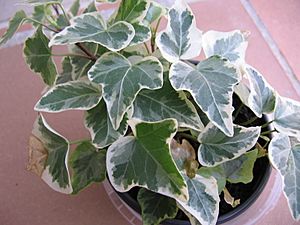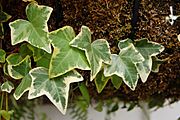Ivy facts for kids
Quick facts for kids Ivy |
|
|---|---|
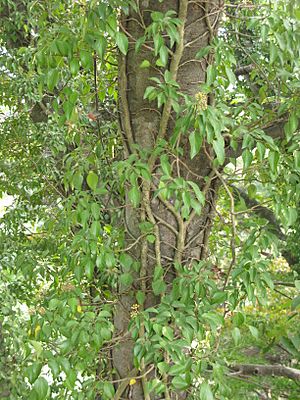 |
|
| Hedera rhombea, Aizu, Fukushima pref., Japan | |
| Scientific classification |
|
| Kingdom: | Plantae |
| Clade: | Tracheophytes |
| Clade: | Angiosperms |
| Clade: | Eudicots |
| Clade: | Asterids |
| Order: | Apiales |
| Family: | Araliaceae |
| Subfamily: | Aralioideae |
| Genus: | Hedera L. |
| Species | |
|
See text |
|
| Synonyms | |
|
|
Hedera, often called ivy, is a group of 12 to 15 types of evergreen plants. These plants are either climbing or creeping along the ground. They are found naturally in parts of Europe, Africa, and Asia, stretching all the way to Japan.
Contents
What is Ivy?
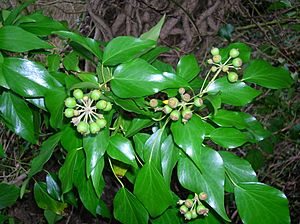
Ivy plants usually stay low to the ground, about 5–20 cm tall. But if they find something to climb, like trees, rocks, or buildings, they can grow very tall, sometimes over 30 meters!
Ivy has two main types of leafes:
- Young leaves: These are shaped like a hand with lobes (like fingers). They grow on stems that creep or climb.
- Adult leaves: These are heart-shaped and don't have lobes. They grow on flowering stems that get lots of sun, usually high up.
The young ivy stems are thin and flexible. They have tiny roots that help them stick to surfaces. The adult stems are thicker and can stand on their own. They don't have these sticking roots.
Ivy flowers are greenish-yellow with five small petals. They grow in clusters in autumn and early winter. These flowers are full of nectar, which is a sweet liquid that attracts insects.
The fruit of ivy is a small berry, about 5–10 mm wide. It can be greenish-black, dark purple, or sometimes yellow. The berries ripen in late winter to mid-spring. Birds eat these berries and help spread the ivy seeds.
Different types of ivy have slightly different leaf shapes and sizes. They also vary in the tiny hairs on their leaves and the size and color of their flowers and fruit.
Where Does Ivy Live?
Ivy plants are originally from Europe, Asia, and North Africa. However, they have been brought to places like North America and Australia. In North America, ivy can sometimes take over natural forest areas. Birds help spread ivy seeds to new places.
Ivy and Nature
Ivy is very important for nature because it provides nectar and fruit. It produces these when other plants might not have much to offer. For example, the ivy bee, Colletes hederae, relies completely on ivy flowers for its food.
Many birds eat ivy berries, including thrushes, blackcaps, and woodpigeons. The leaves are also a food source for the larvae (young forms) of some moths and butterflies. One moth, the small dusty wave, eats only ivy leaves!
Ivy's thick, tangled growth provides a safe home for many small creatures. Insects, birds, and small mammals can shelter and even build nests in ivy. It adds to the variety and complexity of woodland areas.
Types of Ivy
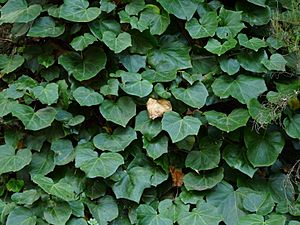
Scientists divide ivy types into two main groups based on the tiny hairs (called trichomes) found on the underside of their leaves:
- Ivy with scale-like hairs:
- Hedera algeriensis – Algerian ivy. Found in Algeria and Tunisia.
- Hedera canariensis – Canaries ivy. Found in the Canary Islands.
- Hedera colchica – Persian ivy. Found in parts of Asia and Turkey.
- Hedera cypria – Cyprus ivy. Found in Cyprus.
- Hedera iberica – Iberian ivy. Found along the coasts of Spain and Portugal.
- Hedera maderensis – Madeiran ivy. Found in Madeira.
- Hedera maroccana – Moroccan ivy. Found in Morocco.
- Hedera nepalensis – Himalayan ivy. Found in the Himalaya mountains and Southwest China.
- Hedera pastuchovii – Pastuchov's ivy. Found in the Caucasus mountains.
- Hedera rhombea – Japanese ivy. Found in Japan, Korea, and Taiwan.
- Ivy with star-shaped hairs:
- Hedera azorica – Azores ivy. Found in the Azores islands.
- Hedera helix – Common ivy. Found widely across Europe.
- Hedera hibernica – Atlantic ivy. Found in Western Europe near the Atlantic Ocean.
Most ivy types are very similar and closely related. Many have been considered variations of H. helix in the past.
There is one known hybrid plant involving ivy called × Fatshedera lizei. It's a mix between Fatsia japonica and Hedera hibernica. This hybrid was first created in a garden in France in 1910.
Uses and Growing Ivy
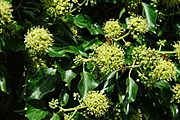
Ivy is very popular for planting in gardens, especially where it grows naturally. People like it because its leaves stay green all year. It also attracts wildlife and can be used to cover walls, fences, or old tree stumps. There are many different types of ivy grown with interesting leaf shapes or colors.
Things to Know About Ivy
Ivy on Trees
People often wonder if ivy harms trees when it climbs on them. In Europe, ivy usually doesn't cause much harm. It might compete a little for water or nutrients. Very old trees with a lot of ivy might be more likely to fall in strong winds. The UK's Woodland Trust says ivy doesn't harm trees and even helps at least 50 types of wildlife.
However, in North America, ivy can be more of a problem. It doesn't have the same natural pests and diseases there that keep it in check. Strong ivy growth can sometimes make it harder for a tree to get sunlight or weaken it, which can lead to the tree dying.
Ivy as an Invasive Plant
Some types of ivy have become a serious invasive species in North America and Australia. This means they spread quickly and can harm native plants. Ivy creates a thick, green cover on the ground that can outcompete local plants.
Because of this, planting ivy as an ornamental plant is now discouraged or even banned in some places. For example, in California, types of ivy from North Africa and Europe were planted in gardens. But they spread aggressively into natural areas, and now expensive programs are needed to remove them.
Is Ivy Poisonous?
The berries of ivy are a little bit toxic. Ivy leaves contain certain chemicals that can cause a skin rash if you touch them.
Ivy and Stinging Insects
Ivy flowers attract many insects that pollinate them, especially Hymenoptera like bees and wasps. The common wasp is particularly drawn to ivy flowers.
Other Names for Ivy
The name "ivy" comes from an old English word. The scientific name Hedera is the old Latin name for the plant. In Britain, ivy used to be called "Bindwood" or "Lovestone" because of how it clings to things. In the US, H. canariensis is sometimes called "California ivy" or "Algerian ivy," and H. helix is often called "English ivy."
The word "ivy" is also used for other plants that are not related to Hedera. These include:
- Boston ivy (a type of creeper)
- Cape-ivy (two different types of plants)
- Poison-ivy (a plant that causes a rash)
- Swedish ivy (a plant with whorled leaves)
Ivy in Culture
Like many plants that stay green all winter, ivy has been seen as special in European cultures. People used to bring it into their homes to keep away bad spirits.
In Ancient Rome, the god Bacchus wore a wreath made of ivy.
In the United Kingdom, ivy bushes or poles wrapped in ivy were traditionally used to advertise pubs. Many pubs are still called "The Ivy."
Because ivy clings to things, it has become a symbol of love and friendship. In the past, priests would give ivy to newly married couples. Since it stays green even when it clings to dead trees, it also became a symbol of eternal life in medieval Christian beliefs.
The famous British Christmas carol, The Holly and the Ivy, uses ivy as a symbol for the Virgin Mary.
Ivy-covered old buildings were a popular subject in Romantic paintings. In these paintings, ivy could show how human things don't last forever and how powerful nature is.
The image of ivy-covered old buildings also gave the name Ivy League to a group of old and famous American universities.
Ivy is also shown a lot in the 2010 movie Arrietty.
Images for kids
-
Ivy climbing on a pine tree (pinus sylvestris) in Headley, UK.
See also
 In Spanish: Hiedra para niños
In Spanish: Hiedra para niños


